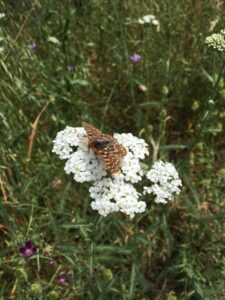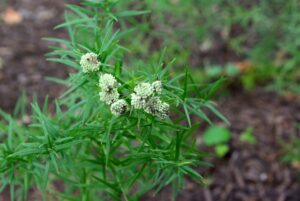Hulda of Bohemia, The Witch of Sleepy Hollow is the inspiration for this fall article on native herbal medicinal plants. Hulda’s gravestone, located at the Old Stone Church in Sleepy Hollow reads:
“Hulda of Bohemia Died c 1777
Herbalist, Healer, Patriot
Felled by British
while protecting the Militia
Buried here in gratitude
for her sacrifice”
Hulda’s story is far too fascinating for me to even try to summarize here, so I highly recommend that you soak up her whole story and sign up for Hulda’s Night at the Rockefeller State Park Preserve before tickets sell out.
But in the meantime, here are some native plants with medicinal qualities that you can grow in your garden.

Yarrow, Achillea millefolium, has white, flat-topped flowers from May to June, is very easy to grow, and attracts many different pollinators and hosts at least ten different types of butterfly and moth larvae. Yarrow can be brewed as a tea or used as an ointment. Yarrow helps to heal wounds and stop bleeding. It can be beneficial to the digestive system by helping to alleviate irritable bowel system. The fresh leaves of yarrow can be chewed to help relieve the pain from a toothache.

If instead you need something a little minty to help heal that toothache, try crushing the flowers of slender mountain mint, Pycnanthemum tenuifolium, to instantly cure the pain. Apparently, you can rub some of the mountain mint leaves on your clothing to serve as a natural insect repellent. Brew the mountain mint as a tea to help treat coughs, fevers, or chills. There are always hundreds of bees buzzing around mountain mint flowers when they are in bloom, all the way from July through September. This flower is also aggressive and can spread, but it’s very adaptable, functional, and beautiful.

Purple coneflower, Echinacea purpurea, has all kinds of healing properties and its flowers, leaves, stems, and roots have been used for centuries to treat medical conditions. The herb is used to reduce the duration and severity of cold symptoms. According to a study by the University of Connecticut School of Pharmacy, Echinacea may lower the risk of developing colds by 58% and shorten the duration of colds by 1.4 days. The plant is known to be a cure-all, boosting immune function, reducing inflammation, relieving pain, and serving as an anti-viral and an antioxidant. To make Echinacea tea, steep a tablespoon of dried Echinacea in a tea infuser for ten minutes, stain into a teacup and add your favorite sweetener. Monarchs, fritillaries, honey bees, and native bees all feed off of the pollen and nectar of the purple coneflower when it blooms from June through August. Leave your coneflower heads standing through the fall and winter to attract songbirds, like goldfinches, to your garden.
While fall is here and you can smell the crisp air and hear the autumn leaves crush underfoot, it’s a great time of year to plant these medicinal native plants in your garden. May the spirit of Hulda the herbalist be with you.
Amanda Bayley is the CEO & Co-Founder of Plan it Wild, a sustainable land management company that is bringing back native habitats to Westchester yards. planitwild.com






